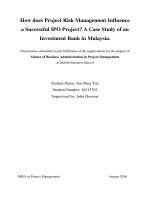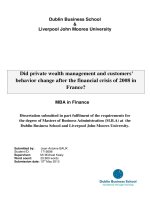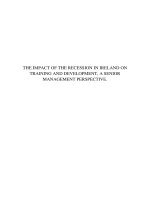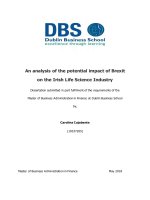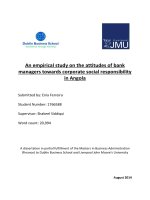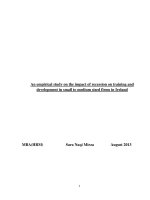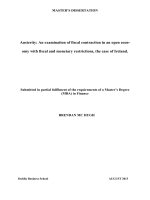Master Thesis in Economics: An analysis of the potential impact of Brexit on the Irish life science industry
Bạn đang xem bản rút gọn của tài liệu. Xem và tải ngay bản đầy đủ của tài liệu tại đây (2.12 MB, 105 trang )
An analysis of the potential impact of Brexit
on the Irish Life Science Industry
Dissertation submitted in part fulfilment of the requirements of the
Master of Business Administration in Finance at Dublin Business School
by,
Carolina Cujabante
(10337205)
Master of Business Administration in Finance
May 2018
Declaration
I, Carolina Cujabante declare that this research is my original work and that it has
never been presented to any institution or university for the award of Degree or
Diploma. In addition, I have referenced correctly all literature and sources used in this
work and this work is fully compliant with the Dublin Business School’s academic
honesty policy.
Signed:
Date: 21st May 2018
i | Page
Abstract
The Irish life Science sector plays a significant role in the Irish Economy, positioning
the country as the largest exporter of Life Science products into the European Union.
The geographic position and strong relationship between Ireland and the UK have
played an eminent role in Ireland’s success. As such, any disruption in the relationship
between the two countries will cause economic, political, and social effects. As of the
29th of June 2016, the UK presented a formal decision to leave the European Union,
in what was known as “Brexit”. This study aims to find out how the Irish Life Science
Industry will deal with this, looking at what major issues are facing the sector in this
uncertain environment of change. Although there has been some research done in the
area, existing literature showed a lack of research into the Irish Life Science sector
itself, in relation to this potential change. Thus, this study will fill such gaps.
The aims of this dissertation were met by an extensive analysis of relevant literature
and through the implementation of a qualitative methodology (interviews). The
research is based on data collected from major Irish entities in the Irish Life Science
industry: Health Products Regulatory Authority (HPRA), Irish Pharmaceutical
Association (IPHA), and the Industrial Development Authority (IDA), with collaboration
from two pharmaceutical companies. Data collection was carried out through semistructured interviews.
The key findings of this research are that Irish Life Science industries see Brexit as a
reality and are preparing for the worst-case scenario, with labelling, regulatory, and
physical changes being the main issues affecting the industry.
The key conclusion drawn from this research was that Brexit would not heavily affect
the Irish Life Science sector, but that a social impact, due to a shortage of medicines,
was to be expected. Due to the unstable and uncertain nature of Brexit, this researcher
recommends further studies be conducted after the agreement between the UK and
the European Union goes though in order to achieve more concrete conclusions.
ii | P a g e
Table of Contents
Declaration ...................................................................................................... i
Abstract...........................................................................................................ii
Table of Contents ............................................................................................ iii
List of Figures ................................................................................................ vii
List of Chart .................................................................................................. viii
List of Tables .................................................................................................. ix
Chapter 1. Introduction .................................................................................... 1
1.1 Research Background .............................................................................. 1
1.2 Aim and Objectives of the Research ........................................................... 2
1.3 Organisation of the dissertation................................................................. 3
1.4 Scope and limitations of the research......................................................... 5
1.5 Industry and major contributions of the research ........................................ 5
Chapter 2. Literature Review ............................................................................. 7
2.1 Introduction............................................................................................ 7
2.2 Understanding Brexit ............................................................................... 7
2.3 Irish Economy......................................................................................... 8
2.4 Relationship between the UK and Ireland ................................................. 10
2.5 Global Life Science Industry .................................................................... 12
2.6 Irish Life Science Sector ......................................................................... 14
2.6.1 Understanding Irish Life Science Industry and Its Operations ............... 18
2.7 Major Issues to be addressed in a potential Brexit ..................................... 20
2.7.1 Trade and Commercial issues ........................................................... 21
2.7.2 Operations and Supply Chain Issues .................................................. 21
2.7.3 Regulatory Issues............................................................................ 22
2.8 Bilateral Trade Agreements..................................................................... 24
iii | P a g e
2.9 Potential Implications of the Irish Life Science Sector and the Irish Economy 25
2.9.1 Drawbacks ..................................................................................... 25
2.9.2 Advantages .................................................................................... 26
Chapter 3. Research Methodology ....................................................................28
3.1 Methodology Introduction....................................................................... 28
3.2 Research Philosophy .............................................................................. 29
3.3 Research Approach ................................................................................ 31
3.4 Research Strategy ................................................................................. 32
3.5 Research Choice .................................................................................... 33
3.6 Time Horizon ........................................................................................ 33
3.7 Sampling - Selecting Respondents ........................................................... 34
3.8 Data collection ...................................................................................... 35
3.9 Research Ethics ..................................................................................... 37
3.10 Research Limitations ............................................................................ 38
3.11 Validity and reliability ........................................................................... 38
Chapter 4. Survey Research Data Analysis and Findings ......................................40
4.1 Introduction.......................................................................................... 40
4.2 Survey Participants ................................................................................ 40
4.3 Data Overview ...................................................................................... 41
4.4 Data Analysis and Findings from entities (IPHA, HPRA and IDA).................. 41
4.4.1 Theme 1: Brexit and Impacts in the Irish Life Science Industry ............. 41
4.4.2
Theme 2: Irish Life Science Relationship with the UK........................ 42
4.4.3
Theme 3: Plans, Expansion and Relocations .................................... 44
4.4.4
Theme 4: Impact on the Irish Economy .......................................... 46
4.5 Data display of Life Science Companies (PC1 and PC2) .............................. 47
4.6 Data Analysis and Findings from Companies (PC1 and PC2)........................ 48
iv | P a g e
4.6.1 Theme 1: Brexit and Impacts in the Irish Life Science Industry: ............ 48
4.6.2 Theme 2: Irish Life Science Relationship with the UK ........................... 49
4.6.3 Theme 3: Plans, Expansion and Relocations: ...................................... 50
4.6.4 Theme 4: Impact on the Irish Economy ............................................. 51
Chapter 5. Discussion......................................................................................52
5.1 Introduction.......................................................................................... 52
5.2 How does the Irish Life Science Industry view Brexit? ................................ 52
5.3 What are the major issues facing the sector in the uncertain environment of
Brexit? ....................................................................................................... 52
5.4 What, potentially, is the major impact Brexit will have on the Irish Life Science
industry?.................................................................................................... 53
5.5 What are Irish Life Science companies actively planning or implementing in
order to prepare for Brexit?.......................................................................... 54
5.6 Investments, Relocations and Expansions................................................. 54
5.7 On what basis are Life Science companies making those decisions?............. 55
5.8 What impact have those decisions on the Irish Life Science sector and on the
Irish economy? ........................................................................................... 56
Chapter 6. Conclusions and Recommendations...................................................57
6.1 Introduction .............................................................................................57
6.2 Conclusions .......................................................................................... 57
6.2.1 Research Objective 1: Identify how the Irish Life Science Industry views
Brexit ..................................................................................................... 57
6.2.2 Research Objective 2: Identify the major issues facing the sector in the
uncertain environment of Brexit. ................................................................ 58
6.2.3 Research Objective 3: Explore what Irish Life Science companies are
actively planning or implementing in order to prepare for Brexit. .................... 59
6.2.4 Research Objective 4: Identify on what basis Irish Life Science companies
are making those decisions ...................................................................... 60
v | Page
6.2.5 Research Objective 5: Evaluate the impact of those decisions on the Irish
Life Science sector and potentially on the Irish Economy ............................. 60
6.3 Recommendations ................................................................................. 61
6.4 Conclusion............................................................................................ 62
Chapter 7. Reflection.......................................................................................64
7.1 Introduction.......................................................................................... 64
7.2 Learning Styles ..................................................................................... 64
7.3 Researcher background.......................................................................... 65
7.4 Master of Business Administration in Finance ............................................ 65
7.5 Dissertation .......................................................................................... 66
Bibliography...................................................................................................69
Appendices ....................................................................................................78
Appendix 1: Good Exports and Imports classified by commodity ...................... 78
Appendix 2: Interview Industrial Development Authority (IDA) ......................... 79
Appendix 3: Interview Irish Pharmaceutical Healthcare Association (IPHA) ........ 83
Appendix 4 - Interview Health Product Regulatory Authority (HPRA) ............... 87
Appendix 5: Pharmaceutical Company (PC1) ................................................. 90
Appendix 6: Pharmaceutical Company (PC2) ................................................. 93
vi | P a g e
List of Figures
Figure 1. Irish Life Science Industry ................................................................... 1
Figure 2. Ireland and UK Trade........................................................................ 11
Figure 3. Research and Development ............................................................... 13
Figure 4. US's top five sources of import of Pharmaceutical Products (2015) ......... 16
Figure 5. Impact of Brexit ............................................................................... 26
Figure 6. The research onion ........................................................................... 29
Figure 7. Sampling Techniques ........................................................................ 34
Figure 8. Qualitative Interview......................................................................... 36
vii | P a g e
List of Chart
Chart 1. Life Science Industry.......................................................................... 14
Chart 2. Value Chain ...................................................................................... 15
Chart 3. Ireland Trade with the UK and the rest of the world .............................. 18
viii | P a g e
List of Tables
Table 1. Impact of Brexit on the Irish Economy ................................................. 10
Table 2. Data Display of entities ...................................................................... 41
Table 3. Data display of Companies ................................................................. 47
Table 4. Investments from 2017 ...................................................................... 55
ix | P a g e
Chapter 1. Introduction
1.1 Research Background
The Life Science sector is comprised of biopharmaceuticals, pharmaceuticals, and
medical device companies, and is the industry responsible for the use of technology
and biology to improve healthcare (Lyons, 2017).
The Life Science sector plays a significant role in the Irish economy, positioning the
country as a world player and the most extensive net exporter in the European Union
(Moran, 2017; Ibec for Irish Business, 2018; IPHA, 2018b). Ireland is home to
approximately 120 Life Science companies, including 9 of the 10 world principal
corporations, making the country a top location for the industry (IPHA, 2018b).
Figure 1. Irish Life Science Industry
(Source: IDA, 2018)
After some discontent regarding European Union rules, in June 2016 the majority of
British citizens voted to exit the European Union, in what was known as “Brexit” (Pruitt,
2017). This formal departure is scheduled for the 29 th of March 2019 (Boyle, 2015;
Hunt & Wheeler, 2017; Lyons, 2017). On the 19 th of March of the present year, 2018,
the European Union and the UK agreed on a transition or implementation of 21 months
after Brexit, until the end of 2020, to provide clarity to people, business, and
governments in order to prepare after Brexit (Clarke and Nobilo, 2018).
1 | Page
Due to the geographic location between the UK and Ireland, and the history between
the countries, any change in the “Single Market Framework” that both countries have
shared, and enjoyed, since 1973, could potentially disrupt the Irish economy also,
especially in relation to the Life Science sector (Smith et al., 2016; Brozak, 2016).
1.2 Aim and Objectives of the Research
This study aims to find out how the Irish Life Science Industry will deal with Brexit,
looking at what major issues are facing the sector in this uncertain environment of
change. Although there has been some research done in the area, existing literature
showed a lack of research into the Irish Life Science sector itself, in relation to this
potential change. Thus, this study will fill such gaps. Seeing that Brexit is a new,
ongoing and uncertain topic, there are limited studies related to any specific
implications it would have on the Irish Life Science Industry. The literature that does
exist offers some papers related to the UK Life Science industry and Brexit, with some
generalisation to the Irish sector. However, the majority are based on projection about
possible scenarios, “post Brexit”, such as borders, customs, and the free movement
of people (potential outcomes), limited on specific impacts on the Irish Life Science
Industry. For that reason, this study aims to improve and fill such gaps with
information from the collection of primary data.
As stated by Kavanagh and Farrell (2017), seeing that Ireland is the largest exporter
of biopharmaceuticals to the EU, it is a reality that Brexit will affect the sector. The
argument is supported by Kazzazi et al. (2017) and Pharmaceutical Executive (2016),
who point out that Brexit poses significant problems to the Life Science sector, with
companies facing new regulations, causing delays in the distribution of medicines,
among other issues. Hence, this study aims to explore the relationship between
Ireland and the UK in relation to this industry, such as in supply chain, imports/exports,
financial cash flow, among other operations, to find out what, if any, the main issues
are that will potentially affect the sector after Brexit.
Primarily, the purpose of this research, is to assess the following - How does the
Irish Life Science Industry view Brexit and what are the major issues facing
2 | Page
the sector in the uncertain environment of BREXIT? The research question
intends to find out, in a potential Brexit scenario, how the Irish Life Science Industry
perceives Brexit and what the main issues affecting Irish Life Science Companies are.
The research question when investigated will help us understand the unforeseeable
implications of a potential Brexit on the Irish Life Science sector, in order to alleviate
any negative impact, if any, or identify potential opportunities for the Irish Life Science
sector going forward.
The research question will be supported by the following sub-research questions:
1)
What are Irish Life Science companies actively planning or implementing in
order to prepare for Brexit?
2)
On what basis are Irish Life Science companies making those decisions?
3)
What impact do these decisions have on the Irish Life Science sector and
on the Irish Economy, potentially?
This study is important and relevant because answering the research and sub-research
questions will help gather the most relevant data from companies and institutions
involved in the sector. In this way, the researcher aims to clarify the position of the
Irish Life Science sector in relation to Brexit, to identify the major issues affecting the
sector, and to evaluate future strategies, among other implications, that could affect
the industry and the Irish economy.
1.3 Organisation of the dissertation
This dissertation is organised into seven chapters:
Chapter 1 - Introduction
This chapter explored the background of the study, highlighting the research and subresearch questions.
3 | Page
Chapter 2 - Literature Review
This chapter will discuss, justify, and contrast and compare relevant literature to gain
an overall view of the topic, highlighting any gaps.
Chapter 3 - Research Methodology
This chapter will describe and justify the research methodology chosen, including
sampling, data collection, and all the activities carried out in this research. Finally,
there will be information on ethics, limitations, and the validity and reliability of the
study.
Chapter 4 - Data Analysis and Findings
In this chapter, the primary data collected will be classified by themes and analysed.
The findings will be illustrated and related to the research and sub research questions.
Chapter 5 - Discussion
This chapter will review and interpret the findings to compare and contrast it with the
literature review, concluding with a detailed explanation of the answers explored in
relation to the research and sub-research questions.
Chapter 6 - Conclusions and Recommendations
This chapter will analyse and link the findings with the aims and objectives of the
investigation, to draw upon a general conclusion. Additionally, it will explain how the
literature review will support the findings. This chapter will highlight some
recommendations for the Irish Life Science Industry, in the eventuality of “Brexit”,
along with highlighting some contributions of this study to the industry.
Chapter 7 – Self-Reflection on Own Learning
This chapter will be an analysis of the researcher’s learning experiences in the master’s
program.
4 | Page
1.4 Scope and limitations of the research
Seeing that Brexit is a new and ongoing phenomenon, a lack of literature will be the
principal limitation of this study. To avoid this issue as much as possible, the researcher
will make the necessary efforts to update until the last moment the information
collected (secondary research). Additionally, this study cannot develop a general
conclusion, as the study finishes before the scheduled date the UK wi ll leave the
European Union. Despite this fact, the researcher made all the efforts necessary to get
access to Irish Life Science companies, to gather some data on this topic. Thus, the
study will be primarily based on the information collected from private and public
entities within the industry.
1.5 Industry and major contributions of the research
“Life Science industry is not just critical to the health of the nation; it plays a critical
and substantial role in the Irish economy” (IPHA, 2018b).
In recent years, Ireland has shown a healthy recovery, becoming the “fastest growing
economy in the European Union” (Ibec for Irish Business, 2017a). As stated before,
the UK is Ireland’s closest partner, thus Ireland is facing a unique challenge in relation
to a potential Brexit. In this regard, any impact (threat or an opportunity) on the Irish
Life Science Industry could extend to the Irish economy, which makes this
dissertation’s topic relevant to those working directly or indirectly, current, or future,
in the Life Science sector.
This dissertation will investigate the industry, detecting and evaluating any potential
impact that could affect the industry, all of which will be relevant in order to help plan
ahead and find out the most suitable strategies to help navigate Brexit. Furthermore,
the benefit of this research is that it can offer recommendations to the industry.
Additionally, as the Irish Life Science Industry offers a variety of employment
opportunities, and because it is the researcher’s intent to stay in the country, this
dissertation will help provide an understanding of how Brexit could potentially affect
the Irish economy and job opportunities.
5 | Page
As Brexit is an ongoing phenomenon, there is a lack of studies related to the Irish
Life Science Sector, which makes this research pertinent, and current.
6 | Page
Chapter 2. Literature Review
2.1 Introduction
This study aims to find out how the Irish Life Science Industry will deal with Brexit,
looking at what major issues are facing the sector in this uncertain environment of
change. Although there has been some research done in the area, existing literature
showed a lack of research into the Irish Life Science sector itself, in relation to this
potential change. Thus, this study will fill such gaps. In recent years, Ireland has
shown a healthy recovery, becoming the “fastest growing economy in the European
Union” (Ibec for Irish Business, 2017a). As stated before, the UK is Ireland’s closest
partner, thus Ireland is facing a unique challenge in relation to a potential Brexit. In
this regard, any impact (threat or an opportunity) on the Irish Life Science Industry
could extend to the Irish economy, which makes this dissertation’s topic relevant to
those working directly or indirectly, current, or future, in the Life Science sector. With
regards to this topic, the literature review is divided into eight themes:
1. Understanding Brexit,
2. Irish Economy,
3. Relationship between the UK and Ireland,
4. Global Life Science Industry,
5. Irish Life Science Industry,
6. Irish Life Science and its Operations,
7. Major issues to be address in a potential Brexit such as: Trade and Commercial
Issues, Operations and Supply Chain, Regulatory and Economic Issues, Bilateral
Agreements,
8. The potential implications of the Irish Life Science sector on the Irish Economy.
2.2 Understanding Brexit
On the 23rd of June 2016, the United Kingdom chose to leave the European Union
after more than forty-three years of membership, with 51.9% voting for "Brexit" and
48.1% for "Remain" (EY, 2016). According to Blagden (2017), the decision to leave
was the result of “economic and cultural divisions”, cross-border factors, weak public
7 | Page
policies, and corporate governance. The UK’s decision was formally presented to the
European Union on the 29 of March 2017.
The UK’s decision to leave does not mean an immediate change, as the inevitable exit
from the EU will happen through procedures established in article 50 of the Lisbon
Treaty. Article 50 stipulates that the process to discuss the agreements of the exit will
take two years at least, and the process includes two separate negotiations:
withdrawal negotiations and the future relationship between the UK and EU. The latter
is expected to be longer (EY, 2016; Smith et al., 2016). On the 19 of March of this
year, the European Union and the UK agreed a transition period of two years “from
29 March 2019 to 31 December 2020” (Pwc, 2018c). During the transition period, the
UK will be able to negotiate its own deals with other countries, but it cannot be put
“into force until after the transition period” (Deloitte, 2016; Pwc, 2018c). In the same
way, during the negotiations period, the UK will still be under European Union
regulations and enjoy its benefits, but the country will not have the right to participate
or vote on issues affecting the European Union. Currently, there are four main issues
that are still outstanding: Agreement on future trade, Resolution for future trade
relations, Irish borders, and “Governance of the withdrawal agreements” (Pwc,
2018c). However, as stated by Merler (2018), the transition deal is not fully
guaranteed, until the successful conclusion of the issues above.
The majority of the literature agrees that Brexit is one of the biggest potential
economic threats to the UK and European Union. Due to its geographic position,
Ireland faces the highest risk. However, the magnitude of the impact is highly
unpredictable, because it is the first time that a country has decided to leave the EU
since its creation, thus there are no historical references or an established process to
refer to (EY, 2016).
2.3 Irish Economy
Before the Financial Crisis, Irish economic performance was recognised by the
Organisation for Economic Cooperation and Development (OECD) as an “Economic
Success Story”. In 2008, with the collapse of Lehman Brothers, Ireland rapidly fell into
8 | Page
a liquidity crisis that caused the Irish Financial Crisis. In 2010, being unable to borrow,
Ireland was forced into an international bailout of €67.5 billion to cover austerity needs
(Ruane, 2016).
The majority of literature reviewed refers to the fact that the Irish economy has thrived
over the last four years, and is still recovering impressively, an argument firmly
supported by Ibec for Irish Business (2017), pointing out that “this time it is most
maintainable than before the financial crisis”. Hannon et al. (2011), Ruane (2016),
and Ibec for Irish Business (2017a), support that the consistently pro-modernisation
of attracting Foreign Direct Investment (FDI) in key sectors and the “second lowest
corporate tax in the European Union”, were some of the core reasons for the Irish
economic recovery. Additionally, McCoy, (2017) and OECD, (2018) reinforce that it
was due to economic policies such as cost-competitiveness, export and domestic
demand. In the same way, Flanagan et al. (2017) state that membership of customs
unions and the single market were essential to Irish economic success.
Currently, Ireland is the fastest growing economy in the Eurozone, and “the 6 th most
competitive in the world”, with the youngest and highly educated population in the
world (IDA, 2017; McCoy, 2017). During 2017, Ireland’s population reported high
levels of living standards and robust growth earnings in the European Union (Ibec for
Irish Business, 2017a). Unemployment has declined, and Ireland has the lowest levels
of inflation within the European Union (Ruane, 2016; Department of Finance, 2018;
OECD, 2018). Additionally, for six consecutive years, Ireland has been recognised as
the best country for its FDI (Ibec for Irish Business, 2017a).
On one hand, the OECD (2018) and The Department of Finance (2018), state that,
despite the fact that the external debt has been significantly paid, private and public
debt still lingers at “pre-crisis levels“, a circumstance that reduces the capability to
deal with economic shocks such a Brexit. Connelly (2017) mentions that “Brexit
represent the single greatest economic and foreign-policy challenge to the Irish state
since the Second World War. There is hardly any area of Irish life that won't be
affected”. Copenhagen Economics (2018) and the European Parliament (2018) argue
that Ireland will be the member most affected by the UK’s withdrawal from the EU.
9 | Page
This argument is widely confirmed in the literature. The following table reflects the
negative impact that Brexit will have on the Irish economy, in all potential scenarios.
Table 1. Impact of Brexit on the Irish Economy
(Source: Copenhagen Economics, 2018)
On the other hand, Flanagan et al. (2017), Ibec for Irish Business (2017b), and McCoy
(2017) show confidence in the fact that Ireland and its business has substantial bases
to cover the impact of Brexit, thus the country “can mitigate the side effect and take
benefit of new opportunities across the world, Canada and Europe”. This argument is
based on the significant improvements and capacity that Ireland has shown in
recuperating from economic shocks. However, to take complete advantage of such
opportunities, it is necessary to focus and prepare, as in McEnaney’s (2017) words,
the Irish government is not being “ambitious enough” in trying to attract companies
based in London.
2.4 Relationship between the UK and Ireland
“Ireland feeds the UK, and they keep us warm at night” (Connelly, 2017).
Previously, in the 1990s, Northern Ireland and the Republic of Ireland had a disruptive
relationship. Hence, in 1998 the “Good Friday” peace agreement and membership in
the European Union abolished border barriers and regulations between the countries
(The House of Lords, 2016; McCoy, 2017). Since 1922, both countries signed a
bilateral Common Travel Area (CTA) agreement, allowing the free movement of people
between the nations, with social security (Horan and Gilmore, 2016; Irish Government
Publication, 2017).
10 | P a g e
Brozak (2016), McCoy (2017), and Copenhagen Economics (2018), state that close
political and cultural ties, land borders, mass movement of people, and strong
economic links are some of the main reasons for the healthy relationship between the
UK and Ireland. It also highlights the implications therefore of how Brexit could affect
such a relationship when the UK choose to leave the EU. Additionally, the UK and
Ireland have very close business integrations, which is the reason why both countries
are regularly seen as one market. Hence, in comparison with other EU members,
Ireland is hugely dependent on trade with the UK and is thus most affected by any
such changes in market dynamics (Copenhagen Economics, 2018, pp. 13-14).
Since 1973, Ireland and the UK joined the European Economic Community, therefore,
trade between both countries has been governed by customs unions and shared
membership of the single market, with no barriers, and stable bilateral agreements,
which is based on the similar regulatory and legal framework, language, time zone,
and geographic position (Department for International Trade, 2018). Hence, Ireland
is still profoundly dependent on the UK as a trading partner (Connelly, 2017; Irish
Government Publication, 2017); for example, pharmaceutical products are the most
substantial goods exported to the UK (Copenhagen Economics, 2018) (see Chart 3).
Figure 2. Ireland and UK Trade
(Source: Copenhagen Economics, 2018)
11 | P a g e
Therefore, “Brexit” will affect both countries, politically and economically (Bergin et
al., 2016). At this point, Connelly (2017) states, it will have “eno rmous economic
implications”. For instance, the European Union trade agreement with Canada took
seven years. Hence, if the UK leaves the single market and the customs union, a new
trade agreement could take a long time to be established. If within the two years, the
UK does not agree on a trade deal, the UK will have to return to WTO rules, causing
an enormous disruption in trade (Connelly, 2017). On the other hand, authors such
as Constance (2017) and Kazzazi (2017) do not see the Irish Life Science sector being
heavily impacted, as it is a robust sector. Furthermore, the Embassy of Ireland (2018),
among other authors, supports the idea that Brexit will not bring about huge
implications for Ireland, based on the goodwill of the “Good Friday Agreement”.
However, Brexit negotiations are still ongoing, which makes it almost impossible for
the researcher, and others, to find out fully how the relationship of the two countries
will be affected and how it will extend to the Irish Life Science Industry. Principally, it
will depend on the agreements explained above, concerning trade, financial cash flow,
and the free movement of people.
2.5 Global Life Science Industry
Considered one of the highest technology sectors, the Life Science Industry is the
authority responsible for the production, development, and promotion of medicines
(Statista, 2018), with the aim to improve health and quality of life (Efpia, 2017). Hence
the industry had made substantial contributions such as reducing death and disability
from diseases, extending the life expectancy of patients, decreasing the spending of
public health, maintaining stable levels of employment, and generating innovative job
opportunities (Phrma, 2012; Muratoglu, 2017). The sector has been historically
dominated by multinational companies from the USA, Western Europe, and Japan
(Achilladelis and Antonakis, 2001). The industry is a sector heavily regulated, at
regional, national, and international levels (Van and Barry, 2008).
12 | P a g e
As stated by Hannon et al. (2011), the Figure 3. Research and Development
success of the industry highly
relies on the challenges related to
the costly, risky, and lengthy
Research and Development (R&D)
of new medicines. Research and
Development processes are the
reason the industry is investing 20
percent or more of its revenues, to
avoid revenue losses resulting
from patent expiry (Statista, 2018).
Source: International Trade Administration, (2016).
To justify the investment, Life
Science companies rely on patents, data protection, and Intellectual Property rights
(IPR) (International Trade Administration, 2016).
According to Gambardella et al. (2000), the Life Science Industry is primarily operated
by multinational companies, and the three different types of firms in this industry are:
-
High Research and Development multinational companies with bases in its own
country market, and transcontinental borders, which cover 40 to 60% of the
global market.
-
Small national companies specialised in the manufacturing and sale of nonintensive biopharmaceutical products in their markets, meaning these firms do
not invest in the Research and Development of medicines.
-
Biotechnology firms, which specialise in the Research and Development of new
components, research tools, and technologies.
The Life Science Industry is one of the fastest growing and most important sectors,
“increasing long-term economic growth” (Muratoglu, 2017). During 2014, the world’s
Life Science Industry reached roughly €965.03 billion, and it is expected to reach
€1,159.7 billion by 2018 (Lehnhausen, 2017 cited in Muratoglu, 2017, p. 1). According
to Deloitte (2018), the industry forecasts growth in sales of 6.5 percent and $1.06
trillion by 2022, resulting from emerging markets.
13 | P a g e
In 2017, North America was the world largest market, with 453 billion in sales,
followed by Europe, with 214 billion in sales. Hence, the sector contributes significantly
to the world economy, providing high wages and quality jobs (Muratoglu, 2017;
Statista, 2018). The USA is the most extensive exporter and importer of Life Science
products, followed by the European Union (See Chart 1).
Chart 1. Life Science Industry
(Source: Statista, 2018)
2.6 Irish Life Science Sector
Being a member the European Union, being an English-speaking country, a
competitive corporate tax rate, and generous R&D tax credit incentives, are some of
the factors positioning Ireland as an excellent place to invest in (Hannon et al. 2011;
Lyons, 2016 & Constance, 2017).
Between the 1960s and 1970s, Irish policies executed by The Industrial Development
Authority (IDA) focused on the attraction of foreign Life Science firms (O’Riain, 2004,
cited in Hannon et al., 2011; Van & Barry , 2008). Therefore, “Ireland is the home of
18 of the top 20 Biopharmaceuticals and 18 of the top 25 medical technology
companies” (Ibec for Irish Business, 2017a). Since its introduction in the 1950s, the
Irish Life Science Industry “has emerged substantially from selling low value-add
manufacturing products to a high-tech manufacturing hub for areas such as
Biopharmaceutical and medical devices” (see figure below). Therefore, the industry is
internationally recognised as one of the leading and advanced sectors in the country,
14 | P a g e
offering the latest technologies and manufacturing six of the top-selling medicines in
the world (Ibec for Irish Business, 2017a; IDA, 2018; IPI, 2018, p. 30). Currently, the
sector is growing from the manufacture of Active Pharmaceutical Ingredient (APIs)
and the packaging of products (Hannon et al., 2011), with increased services and
Research and Development (R&D) (IPI, 2018, p. 30).
Chart 2. Value Chain
(Source: Ibec for Irish Business, 2017a)
Ireland is home to approximately 300 Biopharmaceuticals companies, including plants
and Research centres in collaboration with Irish Universities, and 450 MedTech
domestic companies (IPI, 2018, p. 30). The Irish Life Science sector has produced
significant employment growth; currently, the sector employs around 29,000 people
in the country (Lyons, 2016; Kennedy, 2017; IPHA, 2018). During the last two-years,
biopharmaceutical companies have invested over €4 billion on projects in the country,
generating up to 3,000 new jobs (O’Connor, 2017) and more than €10 billion in the
last decade (Kennedy, 2017). According to a revenue analysis, the manufacturing of
15 | P a g e

